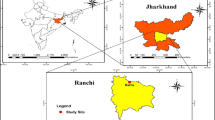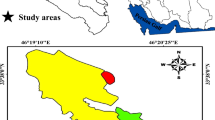Abstract
A study was conducted to evaluate the status of soil nutrients under E. grandis plantation in comparison with that in its adjacent submontane rain forest. Twenty sequare plots, with an area of 20 m×20 m for each, were established in both of E. grandis plantation and its adjacent sub-montane rain forest, independently. Soil samples were collected from each square plot, at five points (at the four corners and at the center) of each plot. The collected soil samples were mixed to make a composite and representative sample for each plot, independently. The analyses were done in a soil laboratory following appropriate methods. The analysis result indicated that there were no significance differences between E. grandis plantation and its adjacent sub-montane rain forest in the level of major soil nutrients (total N, available P, exchangeable K, Ca and Mg), pH and total carbon of soils (p < 0.05). There were significance differences between two sites of forest soils in percentage of clay particles, and exchangeable Na content. E. grandis plantation was found improving soil nutrients and total carbon as compared with that of its adjacent submontane rain forest.
Similar content being viewed by others
References
Ashagrie Y, Zech W, Guggenberger G. 2005. Transformation of a Podocarpus falcatus dominated natural forest into a monoculture Eucalyptus globulus plantation at Munesa, Ethiopia: soil organic C, N and S dynamics in primary particle and aggregate-size fractions. Agriculture, Ecosystems and Environment, 106: 89–98.
Bekel L, Dan BK, Ingvar N, Mats O. 2006. Soil carbon sequestration under different exotic tree species in the southwestern highlands of Ethiopia. Geoderma, 136: 886–898.
Betre A, Tekalign M, Larsson R. 2000. Effects of natural forest conversion to plantation and secondary forests on soil chemical properties in Munessa montane forest, Ethiopia. Ethiopian Journal of Natural Resources, 2: 165–187.
Binkley D, Kaye J, Barry M, Ryan MG. 2004. First rotation changes in soil carbon and nitrogen in a Eucalyptus plantations in Hawaii. Soil Science of America Journal, 68: 1713–1719.
Black CA, Evans DD, White JL, Ensminger LE, Cark FE. 1965. Methods of soil analysis: Part I. Physical and mineralogical properties, including statistics of measurement and sampling. Madison, Winconsin: American Society of Agronomy Ins., pp. 552–562.
Briones MJ, Ineson P. 1996. Decomposition of Eucalyptus leaves in liter mixtures. Soil Biology and Biochemistry, 28: 1381–1388.
Burgess TI, Malajczuk N, Grove TS. 1993. The ability of 16 ectomycorrhizal fungi to increase growth and phosphorus uptake of Eucalyptus globulus Labill. and E. diversicolor F. Muell. Plant and Soil, 153: 155–164.
Chapman HD. 1965. Cation exchange capacity. In: C.A. Black et al. (eds.), Methods of soil analysis. Agronomy 9: 891–901. American Society of Agronomy, Inc. Madison WI.
Cole RJ, Rapp M. 1981. Elemental Cycling in Forest Ecosystems. Cambridge: Cambridge University Press, pp. 341–409.
FAO. 2006. World reference base for soil resources: a framework for international classification, correlation and communication. Rome: FAO, p. 103.
FAO. 1981. Eucalypts for Planting: FAO Forestry and Forest Products Studies 11. Rome: FAO, p. 677.
Heilman P, Norby RJ. 1997. Nutrient cycling and fertility management in temperate short rotation forest systems. Biomass and Bioenergy, 14: 361–370.
Jagger P, Pender J. 2000. The role of trees for sustainable management of less favored lands: the case of Eucalypts in Ethiopia. Washington: International Food Research Institute, p. 81.
Jaiyeoba IA. 2001. Soil rehabilitation through afforestation: Evaluation of the performance of eucalyptus and pine plantations in Nigerian savanna. Land Degradation and Development, 12:183–194.
Lemenih M, Gidyelew T, Teketay D. 2004. Effect of canopy cover and understorey environment of tree plantations on richness, density, and size of colonizing woody species in southern Ethiopia. Forest Ecology and Management, 194: 1–10.
Lemma B. 2006. Impact of exotic tree plantations on carbon and nutrient dynamics in abandoned farmland soils of southwestern Ethiopia. PhD dissertation, Swedish University of Agricultural Sciences, Faculty of Natural Resources and Agricultural Sciences. Uppsala: SLU Service/Repro., p. 42.
Lemma B, Dan BK, Mats O, Ingvar N. 2007. Factors controlling soil organic carbon sequestration under exotic tree plantations: A case study using the CO2FIX model in southwestern Ethiopia. Forest Ecology and Management, 252: 124–131.
Lugo AE, Cuevas E, Sanchez MJ. 1990. Nutrients and mass in litter and top soil of ten tropical tree plantations. Plant and Soil, 125: 263–280.
Marcela CP, Antonio FB, Maria RS. 2009. Aboveground nutrient components of Eucalyptus camaldulensis and E. grandis in semi-arid Brazil under the nature and the mycorrhizal inoculation conditions. Journal of Forestry Research, 20: 15–22.
Maro RS, Chamshama SAO, Nsolomo VR, Maliondo SM. 1991. Soil chemical characterstics in a natural forest and Cupressus lustanica plantation at west Kilimanjaro, Northern Tanzania. Journal of Tropical Forest Science, 5: 465–472.
Mendham DS, Sankaran KV, O’Connell AM, Grove TS. 2002. Eucalyptus globulus harvest residue management effects on soil carbon and microbial biomass at 1 and 5 years after plantation establishment. Soil Biology and Biochemistry, 34: 1903–1912.
Michelsen A, Lisanework N, Friis I, Holst N. 1996. Comparisons of understory vegetation and soil fertility in plantations and adjacent natural forests in the Ethiopian Highlands. Journal of Applied Ecology, 33: 627–642.
Mulugeta Z. 2008. Temporal changes of biomass production, soil properties and g round flora in Eucalyptus globulus plantations in the centeral highlands of Ethiopia. Doctoral thesis, Swedish University of Agricultural Science, Uppsala, SLU Service/Repro., p. 74.
Nsabimana D, Klemedtson L, Kaplin BA, Wallin G. 2008. Soil carbon and nutrient accumulation under forest plantations in southern Rwanda. African Journal of Environmental Science and Technology, 2: 142–149.
Olsen SR, Cole CV, Watanabe S, Dean LA. 1954. Estimation of available phosphorus in soils by extraction with sodium bicarbonate. USDA circular no., 939: 1–19.
Pohjonen V, Pukkala T. 1990. Eucalyptus globulus in Ethiopian forestry. Forest Ecology and Management, 36: 19–31.
Poore MED, Fries C. 1985. The ecological effect of eucalyptus. Rome: FAO, p. 87.
SAS. 2003. SAS System Softtware Version 9.1. CD SAS Institute Inc. Cary, NC, USA.
Schnitzer M. 1982. Total carbon, organic matter. In: Page, A.L., Miller, R.H., Keeney, D.R., (eds), Methods of soil analysis: Part 2. Agronomy Monograph, vol. 9, 2nd edition. Madison: American Society of Agronomy, pp. 539–577.
Shan J, Morris LA, Hendrick RL. 2001. The effect of management on soil carbon and plant carbon sequestration in slash pine plantations. Journal of Applied Ecology, 38: 932–941.
Shiferaw A, Tadesse W. 2009. A comparative assessment on regeneration status of indigenous woody plants in Eucalyptus grandis plantation and the adjacent natural forest. Journal of Forestry Research, 20: 31–36.
Sing K, Chauhan HS, Rajput DJ, Singh D.V. 1989. Report of a Sixty Month Study on Litter Production, Changes in Soil Chemical Properties and Productivity under Poplar (P. deltoides) and Eucalyptus (E. hybrid) Interplanted with Aromatic rasses. Agroforestry Systems, 9: 37–45.
Tefere M, Chernet T, Haro W. 1999. Explanation of the geological map of Ethiopia, 2nd ed. Addis Ababa: EIGS technical publication team, Addis Ababa, p. 79.
Turnbull JW, Pryor LD. 1978. Choice of Species and Seed Source. In: W.E Hillis. and A.G. Brown (eds), Eucalyptus for Wood Production. Australia: CSIRO, Adelaide, p. 6–65.
Turner J, Lambert MJ. 1983. Nutrient cycling within a 27 Year Old Eucalyptus grandis plantation in New South Wales. Forest Ecology and Management, 6: 155–168.
Zhang XQ, Kirschhaum MUF, Hou Z, Guo Z. 2004. Carbon stock changes in successive rotations of Chinese fir (Cunninghamia lanceolata (lamb) Hook) plantations. Forest Ecology and Management, 202: 131–147.
Zhang H, Zhang GL, Zhao YG. 2007. Chemical degradation of Ferralsol (Oxisol) under intensive rubber (Hevea brasiliensis) farming in tropical China. Soil and Tillage Research, 93: 109–116.
Author information
Authors and Affiliations
Corresponding author
Additional information
Foundation project: This work is supported by the Canadian International Development Agency (CIDA).
Rights and permissions
About this article
Cite this article
Alem, S., Woldemariam, T. & Pavlis, J. Evaluation of soil nutrients under Eucalyptus grandis plantation and adjacent sub-montane rain forest. Journal of Forestry Research 21, 457–460 (2010). https://doi.org/10.1007/s11676-010-0097-9
Received:
Accepted:
Published:
Issue Date:
DOI: https://doi.org/10.1007/s11676-010-0097-9




